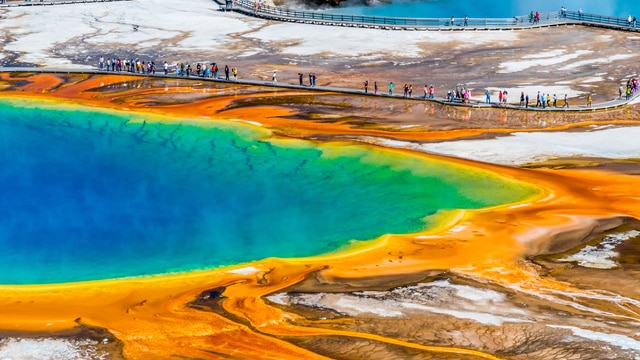What’s the climate like in Pennsylvania?
The current climate in Pennsylvania features temperatures ranging from a high of 30°C to a low of 2°C throughout the year. The average yearly temperature is around 17°C. At night, temperatures in the colder months average around -6°C and in the warmer months around 18°C.
The highest temperature recorded in Pennsylvania in recent years was 37°C in July 2020. The lowest daytime temperature recorded was -15°C in January 2014.
On average, Pennsylvania gets 1949 mm of precipitation each year. Of this, about 115 cm is snowfall. For comparison, New York gets 1142 mm of precipitation each year.
The climate in Pennsylvania is based on weather data from . Other places, like New York City, Miami or Los Angeles, might have different weather. You can check out all destinations in Pennsylvania to get the full picture of the climate.
Best time to visit Pennsylvania?
The best time to visit Pennsylvania for mild to warm weather is April up to October. You might get some rain, but the temperatures are just right to explore Pennsylvania.
Climate Table of Pennsylvania
The climate table of Pennsylvania shows the average temperatures, rainfall, snow, and UV index per month. The table provides an overview of the average day and night temperatures in degrees Celsius, the total amount of rainfall in millimeters, the total snowfall in centimeters, and the UV index for each month. Rainfall is always measured as water, even if it's snow or hail.
| Jan | Feb | Mar | Apr | May | Jun | Jul | Aug | Sep | Oct | Nov | Dec | |
|---|---|---|---|---|---|---|---|---|---|---|---|---|
| Temp. max (°C) | 2 | 4 | 9 | 17 | 23 | 27 | 30 | 29 | 25 | 18 | 11 | 6 |
| Temp. min (°C) | -6 | -5 | 0 | 5 | 11 | 16 | 19 | 18 | 14 | 9 | 1 | -1 |
| Precipitation | ||||||||||||
| Precipitation (mm) | 111 | 139 | 114 | 163 | 185 | 170 | 249 | 207 | 170 | 173 | 118 | 150 |
| Snow (cm) | 27 | 33 | 17 | 4,9 | 0 | 0 | 0 | 0 | 0 | 0 | 8,7 | 24 |
| UV Index | 2 | 3 | 3 | 6 | 6 | 6 | 6 | 6 | 6 | 3 | 2 | 2 |
Click on the month name to see more weather details, like daily averages, temperatures, and precipitation for the past years in that month.
- Average yearly temperature: 17°C
- Highest temperature: 30°C in July
- Lowest temperature: 2°C in January
- Precipitation*: 1949 mm per year, averaging 162 mm per month
- Snowfall: 115 cm per year
- Driest months: 111 mm in January, 114 mm in March and 118 mm in November
- Wettest months: 249 mm in July, 207 mm in August and 185 mm in May
*Precipitation is measured as a combination of rain, snow, and hail
Average Temperature per Month in Pennsylvania
This graph shows the average maximum temperatures per month in Pennsylvania, United States. The temperatures are shown in degrees Celsius and the average is calculated based on the recorded temperatures per month from past years.
Average Precipitation per Month in Pennsylvania
This graph shows how much rainfall Pennsylvania, United States, gets on average per month. Rainfall is always measured as water, even if it's snow or hail. This makes it easy to compare how much has fallen, regardless of the form of precipitation. The amount of rainfall is measured in millimeters, and the average is calculated based on the recorded rainfall per month from past years.
Average Snowfall per Month in Pennsylvania
This graph shows how much snow Pennsylvania, United States, gets on average per month. The amount of snowfall is measured in centimeters and the average is calculated based on the recorded snowfall per month from past years.
Average UV Index per Month in Pennsylvania
This graph shows the average UV index per month in Pennsylvania, United States. The UV index indicates the intensity of ultraviolet radiation and ranges from 0 to a maximum of 11.
Yearly Temperature in Pennsylvania
This graph shows the average yearly temperature in Pennsylvania, United States. The yearly temperature, expressed in degrees Celsius, is the average of all twelve monthly temperatures summed up for that year.
Total Yearly Precipitation in Pennsylvania
This chart shows the total yearly precipitation in Pennsylvania, United States, over the past few years. The total yearly precipitation, measured in millimeters, is the sum of all the rain that fell in the twelve months of that year.
Total Yearly Snowfall in Pennsylvania
This chart shows the total yearly snowfall in Pennsylvania, United States, over the past few years. The total yearly snowfall, measured in centimeters, is the sum of all the snow that fell in the twelve months of that year.
Weather experiences in Pennsylvania
Have you been to Pennsylvania?
Share your weather experiences in Pennsylvania.
Average weather in Pennsylvania by month
Click on a month below to see detailed weather info for Pennsylvania. Based on historical weather data, you can see the average temperature, precipitation, wind, and UV index for each day of the month.
Popular destinations in United States
Discover the climate of these popular destinations in United States.












